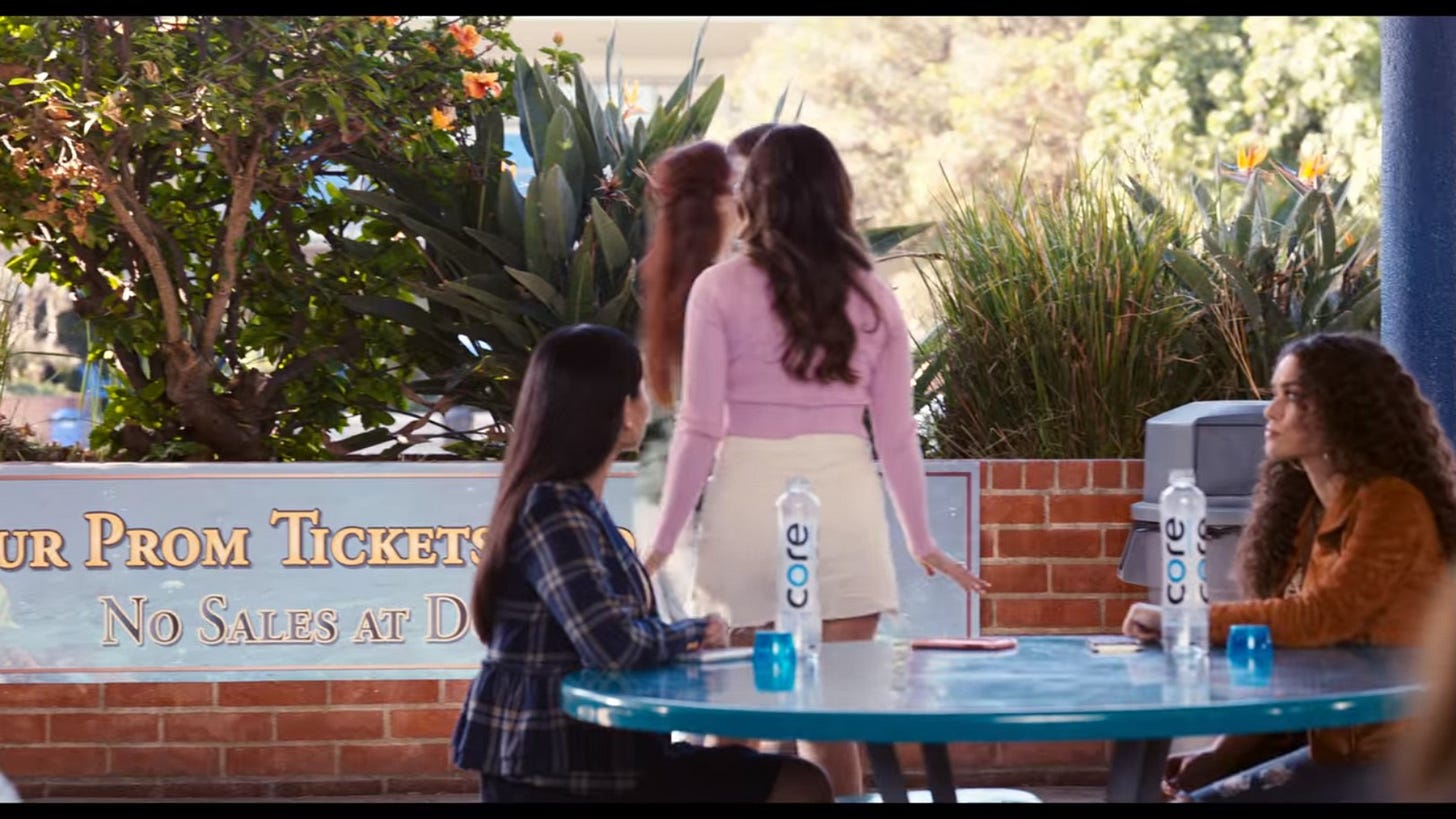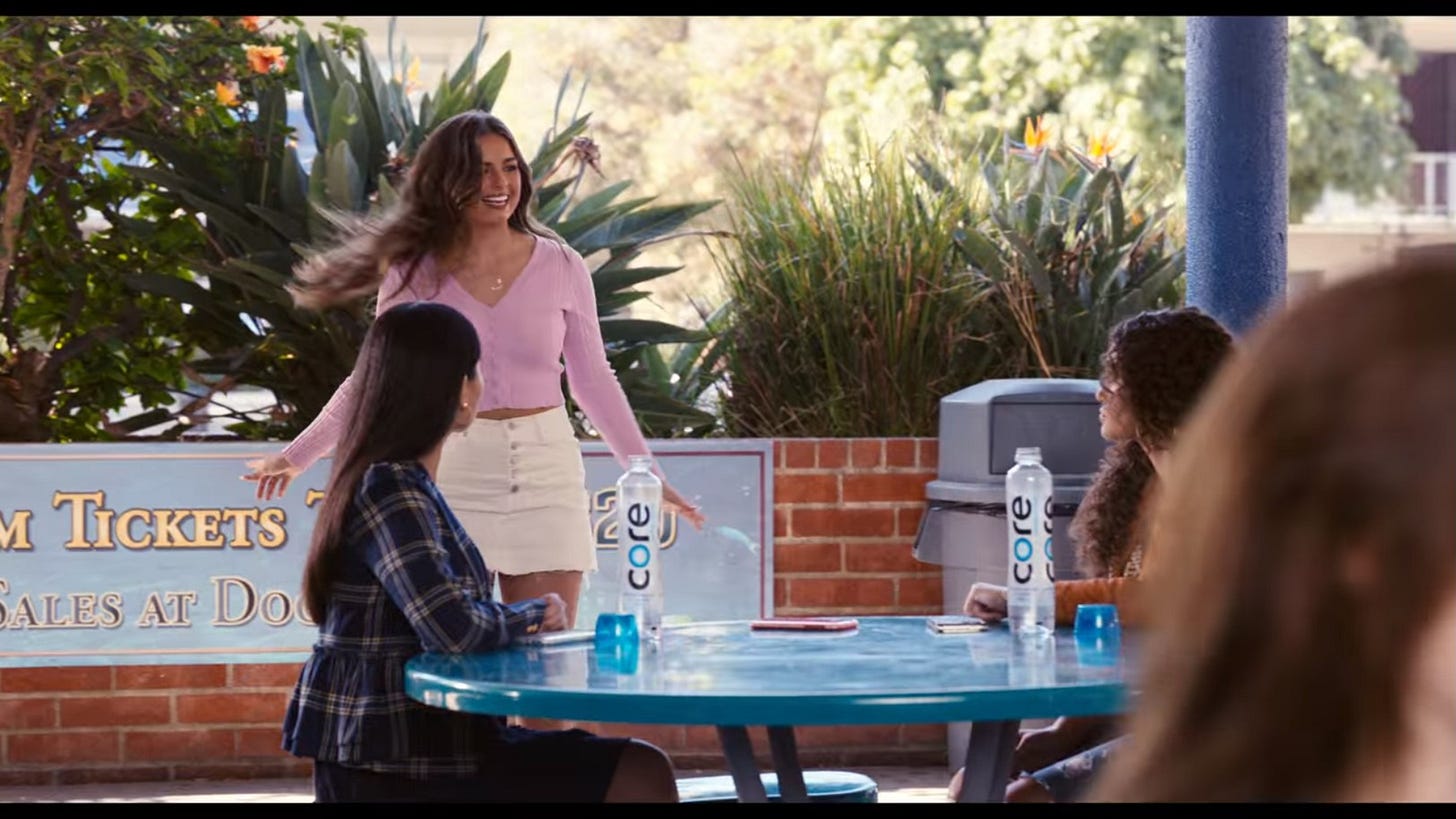On its face, She’s All That is a perfect candidate for a decades-later remake. Its Pygmalion-ish transformation of a nerdy outcast into foxy prom-ready date for the big man on campus is practically a remake already; the 1999 film is beloved by a certain segment of a certain age, as nearly every teen movie ever made (with the possible exception of Whatever It Takes) but isn’t an unimpeachable (or easy-to-ruin) classic; and teen trends and mores have cycled through so much since ’99 that carbon-copying the original would be nearly impossible.
And yet the Netflix redo He’s All That feels like an old-fashioned science experiment, where several of its major creative elements serve as a de facto control groups. The screenplay credit is once again to R. Lee Fleming, whose name adorns the original; did he actually tweak his pre-existing script, or were the tweaks of others not sufficient enough for a shared credit? The original director hasn’t been retained, but newbie Mark Waters did make the genuine teen classic Mean Girls, which is now emblematic of the 2000s that the very-late-‘90s She’s All That was ushering in. (That is, using the traditional definition of “to usher,” as in “to guide,” rather than “to sequester in a DJ booth and edit into a film as if a proper cast member.”) It even recreates the low expectations of a late-January theatrical release in 1999: It’s a Netflix original released in the thick of August doldrums.
The experiment fails, and not in the way you might expect. This isn’t a listless, embarrassingly faithful re-enactment of She’s All That (though it certainly has elements of that dead-end approach to remakes). He’s All That is, somehow, a borderline disaster, ineptly reclaimed with all the grace of a high-concept ad. How did this happen? What is the crucial missing ingredient? It can’t be the original leading lady Rachael Leigh Cook, because she is present and accounted for here, as the lead character’s mother, as is the first movie’s scene-stealer Matthew Lillard, doing the same courtesy here from another vantage. It can’t be Freddie Prinze Jr. because, well, check out the original She’s All That for why. (Nothing against Prinze, but he’s among the least irreplaceable actors of his time.) Is it M. Night Shyamalan, who did an uncredited rewrite on the first script? Are we witnessing a belated filming of a rougher, unmade earlier draft, before Shyamalan improved it with his uncanny ear for the music of snappy dialogue? Though I have a lot of respect for Shyamalan as a writer—Old is one of the best movies of the summer!—I also have to say no, that doesn’t seem like it, either.
I think the arrhythmia of He’s All That has a different source, and it’s not going to sound kind when I say it’s Addison Rae, the young conqueror of TikTok who plays Padgett, the gender-swapped movie’s equivalent of the Prinze character from the original. Padgett is also a social-media dynamo, though not quite at Rae’s level, and honestly, this convenient adjustment is kind of a brilliant idea for a remake of such a makeover-centric movie: When Padgett is humiliated by a publicly streamed break-up with another Very Online Celeb and loses a burgeoning sponsorship deal that was going to help her pay for college, she accepts a challenge to make over any old high school loser into a prom king. The chosen one is Cameron (Tanner Buchanan), a hodgepodge of antiestablishment, antisocial cliches from the ‘90s that have only been mildly updated for the era of social media.
Weirdly, the movie doesn’t capitalize on Cameron’s Luddite tendencies; it fails to fully digitize Padgett’s challenge, which is framed as an old-fashioned bet from a frenemy, just like the original. Wouldn’t it make more sense for Padgett to make this scheme part of her ongoing livestreams, thus necessitating a subject who’s not online enough to know that he’s being turned into an amateur reality-show celeb against his will? Maybe that’s a bit dark for the Netflix She’s All That remake, but it would go a long way to explaining why the movie chooses Rae as its subject. As-is, Rae gives one of the strangest and least engaging lead performances I’ve seen in a professionally produced movie in years.
It is not especially insightful to point out that Rae, who gained fame as a TikTok dancer and has never acted in a live-action movie before, is not naturally convincing in the movie, even given the seemingly workable parameters of the role “teenage girl who films herself doing stuff.” (In fact, she’s closer in age to her character than a lot of teen-movie performers; Prinze was several years older when he shot the earlier film.) But the specific badness of Rae’s performance is trickier to grasp. At times, it feels absent of any proper intonation, like the whole of her being has been fed through the mildly clenched teeth of a polite smile. Early in the movie, her character has a phone call with a character played by Kourtney Kardashian, and it feels like strategic misdirection: Maybe Rae will look natural intercut with someone who sounds truly, thoroughly, skit-at-a-sales-conference wooden.
And it is effective in clarifying how Rae’s bad acting is distinct from the Kardashian house style of vacantly confident pronouncement. But Rae still sounds and even somehow looks adrift here, resorting to a series of eye-crinkles and abashed smiles that turn out to be just closing her eyes and tilting her head. It is a fascinating combination of someone who is deeply uncomfortable on camera yet doesn’t seem to know it.
You can forgive Rae the mistake; her whole career to this point has been on camera, so naturally she assumes she’s, well, a natural. Here’s my related theory: Everything Rae has failed to learn about acting, she’s failed to learn from being on TikTok. I mean, obviously her work on TikTok is a huge win; she’s something like the third most-followed account on that platform, and unlike Padgett, she’s in no danger of losing her sponsorship deals. Why, the very thought of it has made me positive starving for something today’s teens love… Pizza Hut!
Anyway, early in He’s All That, Yum! Brands Presents Addison Rae is having the same chat that Freddie Prinze had with Paul Walker in the earlier film: laying out her hurt and vexation over a recent break-up as her friends eventually suggest redemption via cruel gambling. In He’s All That, the blocking of the scene requires that Rae stand up from a lunch table, turn around, and face her friends, presumably to add some physical expression to a scene that otherwise proceeds as a creepy simulation of friends laughing, augmented with branded reaction shots. This does not do the trick. It’s a small moment, but like so many others in He’s All That, it’s plagued by Rae having no real sense of physical space around her. She doesn’t know how to react to other performers, or even work with the meager environment she finds herself in. A bizarre vacuum forms, with a radius of about five feet around her performance.
People will call me crazy, but it’s similar to—albeit much worse than—a quality I clocked in Jennifer Hudson in Dreamgirls, her straight-from-American Idol film debut, for which she won an Academy Award. There’s a scene in that movie where she shares a back-and-forth song with Jamie Foxx, and in the half of the scene where he’s singing, there’s very little going on in Hudson’s eyes—hardly so much as a reaction. She’s waiting for her turn to sing.
So is Rae waiting for her turn to do a TikTok dance? It comes late in the movie, as it did in She’s All That, with a choreographed prom dance, announced with the customary self-referential wink. (This time it’s Matthew Lillard who Ushers his way through a series of PA announcements and makes a prom appearance, though he’s allowed to occasionally share the frame with other lead actors.) Granted, it’s not fair to judge Rae’s dancing based on this horribly directed sequence. But it does look like much of it consists of dramatic arm movements while rhythmically walking. In other words, the dance moves look a lot like [what I’ve seen of] Rae’s TikTok videos: Medium-impact exercise vids designed for a small, vertically oriented, phone-sized screen, to be performed 30 seconds at a time. It feels like TikTok has influenced her performance throughout the movie; she keeps throwing out a big, simple expressions—eyes open, then closed; get up, then spin around—that look like what you do at the end of a 30-second dance. No wonder Rae looks lost, even on a direct-to-streaming movie: Look at all that extra space she’s expected to inhabit.
To be fair, this kind of self-awareness, intuition, and joy of perfromance, might be a lot to ask of a 20-year-old on her first movie. But then again, why is she starring in He’s All That in the first place? I’m not defending the sanctity of a gender-flipped remake of a marginal teen movie elevated by its box office success and a couple of memorable moments. I am, though, conscious of how Netflix seems to command a sizable chunk of the audience for teen movies, what with its Kissing Booths and To All the Boyses, as well as rom-#comtent, and I do believe fans of That Type of Stuff (a group that I obviously, albeit somewhat torturously, belong to) deserve movies starring people who actually like movies, rather than seeing them as a subsidiary of their TikTok empire. Addison Rae doesn’t look especially excited or moved by anything happening in the movie that she’s starring in. She’s just there, photographed as prominently and helplessly as those plastic-looking slices of Pizza Hut-brand pizza product. Product placement is one thing; by the end, He’s All That feels like human placement.









